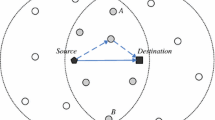Abstract
Nowadays, some of the more exciting research areas in networking are based on cooperation between network nodes. Examples of this are ad-hoc or sensor networks, cooperative physical layer techniques known as cooperative diversity, or other new cooperative mechanisms such asCooperative ARQ. In many scenarios, this cooperation could be further exploited using new mechanisms that fall into the L2-L3 protocols, leading to a cooperative stack. These mechanisms allow an easy use of the resources of adjacent nodes to increase communication capabilities. This combines particularly well with the characteristics of wireless networks thanks to the broadcast advantage inherent in wireless transmission. This paper proposes a novel cooperative relaying scheme that exploits transmitter diversity and performs a fast path repair procedure at L2. All these operations are made transparently to the content of the forwarding tables of the nodes, thanks to the use of a new addressing scheme. This protocol could work together with other cooperative protocols such as Cooperative ARQ, leading to an integrated mechanism for frame relaying. Analytical and simulation results show that cooperative frame relaying clearly improves network resilience.
Preview
Unable to display preview. Download preview PDF.
Similar content being viewed by others
References
Androutsellis-Theotokis, S., Spinellis, D.: A Survey of Peer-to-Peer Content Distribution Technologies. ACM Computing Surveys 36(4) (2004)
Goldsmith, A.: Wireless Communications. Cambridge University Press, Cambridge (2005)
Liu, P., Tao, Z., Panwar, S.S.: A Cooperative MAC Protocol for Wireless Local Area Networks. In: IEEE ICC’05, IEEE Computer Society Press, Los Alamitos (2005)
Miu, A., Balakrishnan, H., Koksal, C.E.: Improving Loss Resilience with Multi-Radio Diversity in Wireless Networks. In: ACM Mobicom 2005, Cologne, ACM Press, New York (2005)
Morillo, J., García-Vidal, J., Pérez-Neira, A.: Collaborative ARQ in Energy-constrained Wireless Networks. In: Third ACM/SIGMOBILE Workshop on Foundation of Mobile Computing DIAL-M-POMC, ACM, New York (2005)
Srivastava, V., Motani, M.: Cross-layer design: a survey and the road ahead. IEEE Communications Magazine (December 2005)
Ramanathan, R.: Challenges: A Radically New Architecture for Next Generation Mobile Ad Hoc Networks. In: ACM Mobicom 2005, Cologne, ACM Press, New York (2005)
Nosratinia, A., Hunter, T.E., Hedayat, A.: Cooperative Communication in Wireless Networks. IEEE Communications Magazine (October 2004)
Monti, P., Tacca, M., Fumagalli, A.: Optimized Transmission Power Levels in a Cooperative ARQ Protocol for Microwave Recharged Wireless Sensors. In: IEEE ICC’05, IEEE Computer Society Press, Los Alamitos (2005)
Zhao, B., Valenti, M.C.: Practical Relay Networks: A Generalization of Hybrid-ARQ. IEEE JSAC 23(1) (2005)
Zhang, Q., Kassam, S.A.: Finite-State Markov Model for Rayleigh Fading Channels. IEEE Transactions on Communications 47(11), 1688–1692 (1999)
Perkins, C.E., Belding Royer, E.M., Das, S.R.: Ad hoc On-Demand Distance Vector (AODV) Routing. RFC 3561 (November 2003)
Khandani, A.E., et al.: Cooperative Routing in Wireless Networks. In: Allerton Conference on Communications, Control and Computing (October 2003)
Author information
Authors and Affiliations
Editor information
Rights and permissions
Copyright information
© 2007 Springer Berlin Heidelberg
About this paper
Cite this paper
García-Vidal, J., Guerrero-Zapata, M., Morillo-Pozo, J., Fusté-Vilella, D. (2007). A Protocol Stack for Cooperative Wireless Networks. In: García-Vidal, J., Cerdà-Alabern, L. (eds) Wireless Systems and Mobility in Next Generation Internet. EuroNGI 2006. Lecture Notes in Computer Science, vol 4396. Springer, Berlin, Heidelberg. https://doi.org/10.1007/978-3-540-70969-5_5
Download citation
DOI: https://doi.org/10.1007/978-3-540-70969-5_5
Publisher Name: Springer, Berlin, Heidelberg
Print ISBN: 978-3-540-70968-8
Online ISBN: 978-3-540-70969-5
eBook Packages: Computer ScienceComputer Science (R0)




